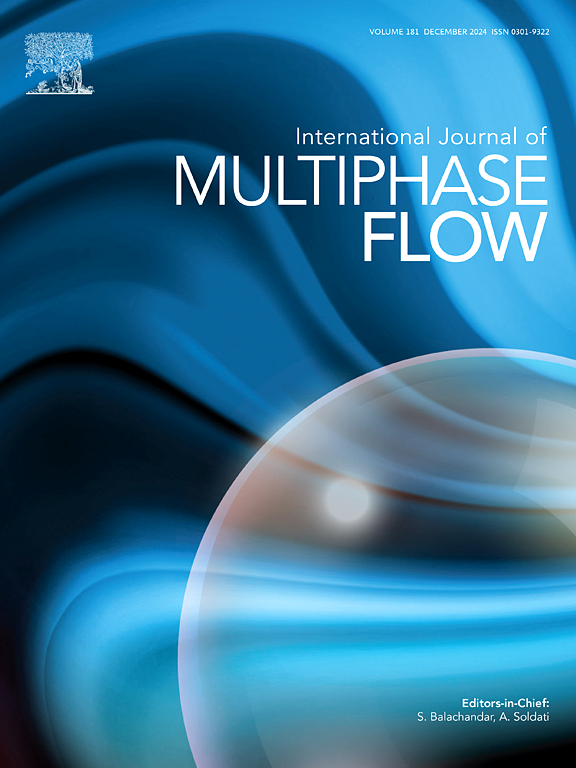Multiphase flow of dense granular material in a partially filled rotating drum
IF 3.6
2区 工程技术
Q1 MECHANICS
International Journal of Multiphase Flow
Pub Date : 2025-05-15
DOI:10.1016/j.ijmultiphaseflow.2025.105286
引用次数: 0
Abstract
The two-dimensional granular flow within a partially filled rotating drum is investigated, using a stabilized Finite Element algorithm, coupled with a phase field method for capturing the interface between the granular medium and ambient air. The granular material rheology is modelled using the constitutive equation within a continuum framework. A mesh-dependent instability associated with the original rheology is identified, which is observed for the first time in the rotating drum configuration. This instability is removed by employing the partially regularized -model proposed by Barker and Gray (2017), leading to stable simulations. We successfully reproduce the characteristic flow dynamics, reported in experimental studies, including the formation of the active and passive layers, and we compute the thickness of the active layer at mid-chord. We visualize the yielded/unyielded regions using the Drucker-Prager criterion, showing a strong resemblance to the active/passive layers. Through extensive parametric analysis, we explore the effects of angular velocity, filling degree, static friction coefficient and grain diameter on the flow. Our results provide insights into the relationship between these parameters and key flow characteristics, such as the kinetic energy, the dynamic angle of repose, the active layer thickness, and the yielded region dynamics.
致密颗粒物料在部分填充的旋转滚筒内的多相流动
采用稳定有限元算法,结合相场法捕捉颗粒介质与周围空气之间的界面,研究了部分填充旋转鼓内的二维颗粒流动。采用连续介质框架下的μ(I)本构方程对颗粒材料流变进行了建模。发现了与原始μ(I)流变相关的网格依赖不稳定性,这是首次在转鼓结构中观察到。通过采用Barker和Gray(2017)提出的部分正则化μ(I)-模型来消除这种不稳定性,从而实现稳定的模拟。我们成功地再现了实验研究中报道的特征流动动力学,包括主动层和被动层的形成,并计算了中弦处主动层的厚度。我们使用Drucker-Prager标准可视化屈服/未屈服区域,显示出与主动/被动层的强烈相似性。通过广泛的参数分析,探讨了角速度、填充度、静摩擦系数和颗粒直径对流动的影响。我们的研究结果揭示了这些参数与关键流动特性(如动能、动态休止角、活动层厚度和屈服区动态)之间的关系。
本文章由计算机程序翻译,如有差异,请以英文原文为准。
求助全文
约1分钟内获得全文
求助全文
来源期刊
CiteScore
7.30
自引率
10.50%
发文量
244
审稿时长
4 months
期刊介绍:
The International Journal of Multiphase Flow publishes analytical, numerical and experimental articles of lasting interest. The scope of the journal includes all aspects of mass, momentum and energy exchange phenomena among different phases such as occur in disperse flows, gas–liquid and liquid–liquid flows, flows in porous media, boiling, granular flows and others.
The journal publishes full papers, brief communications and conference announcements.

 求助内容:
求助内容: 应助结果提醒方式:
应助结果提醒方式:


